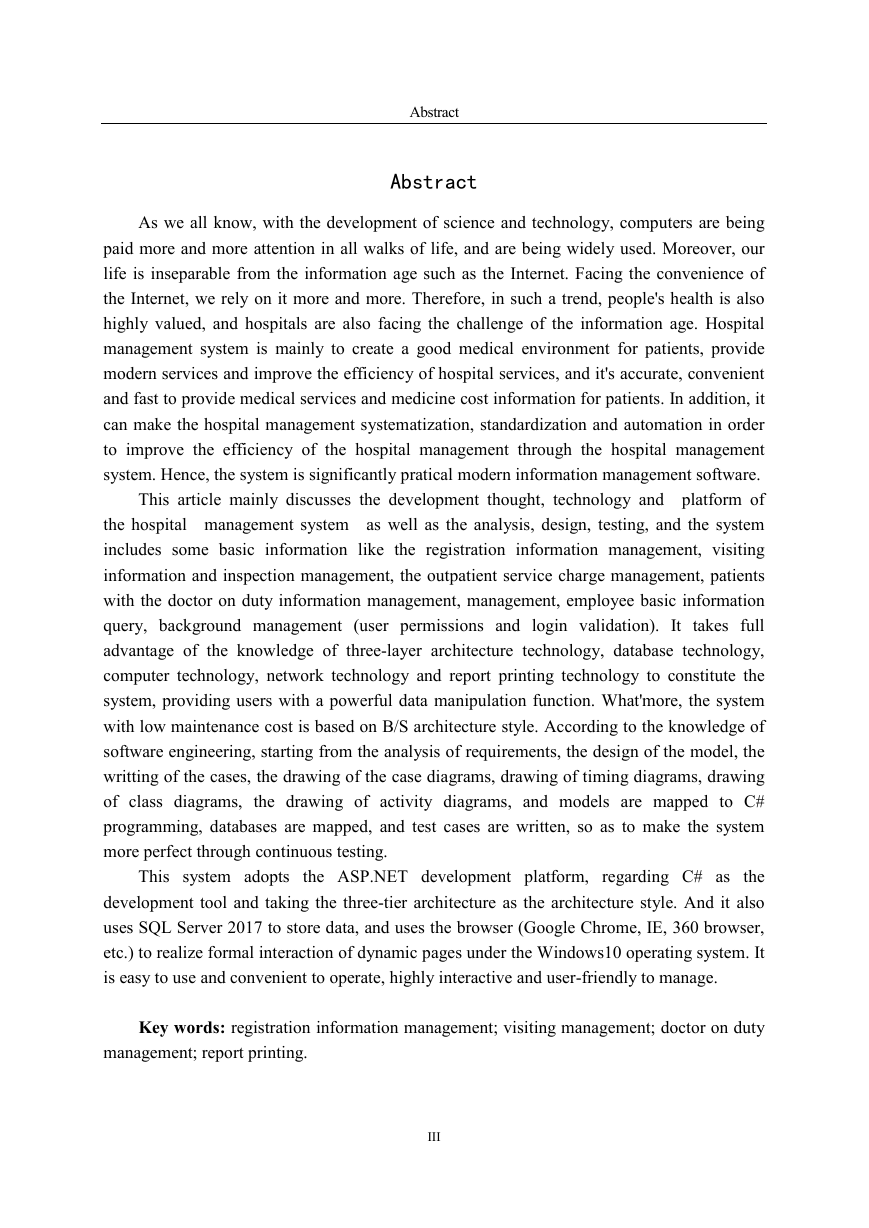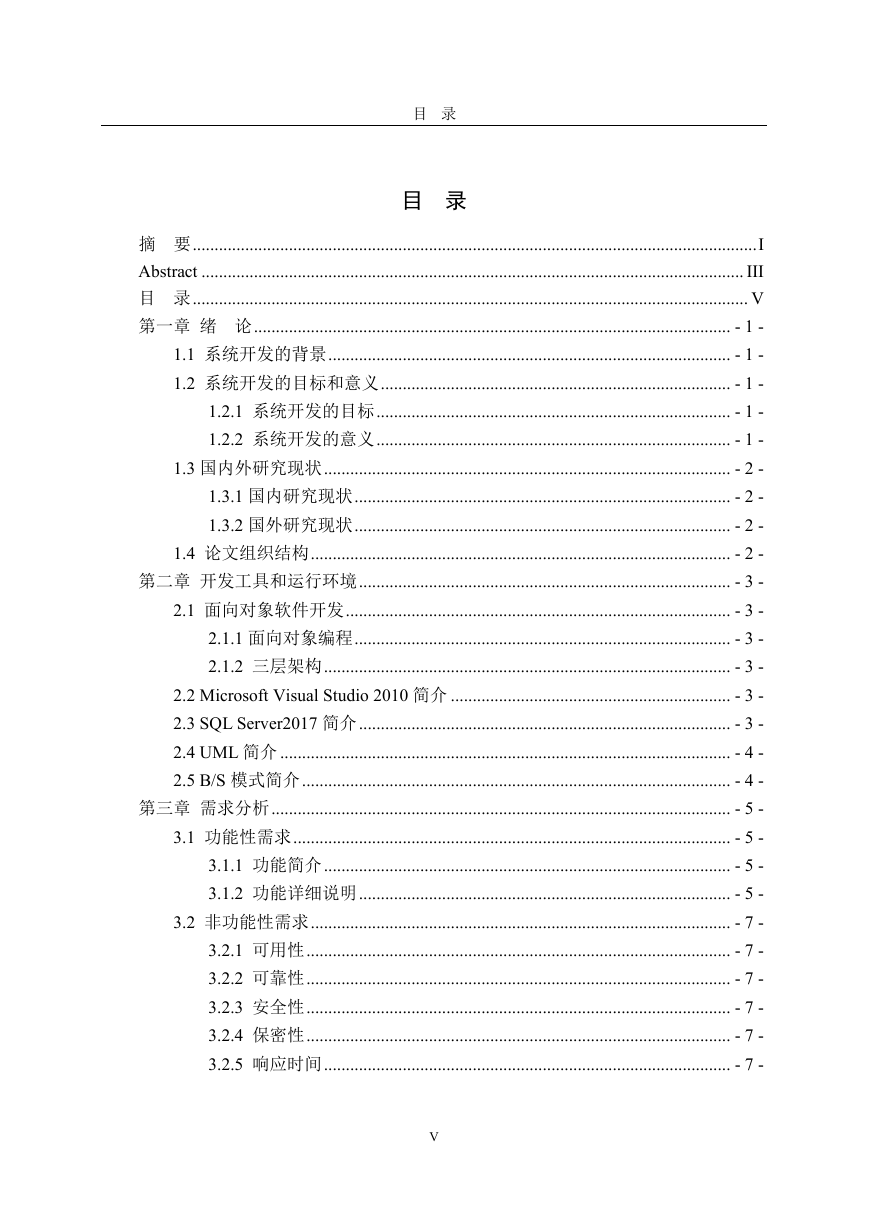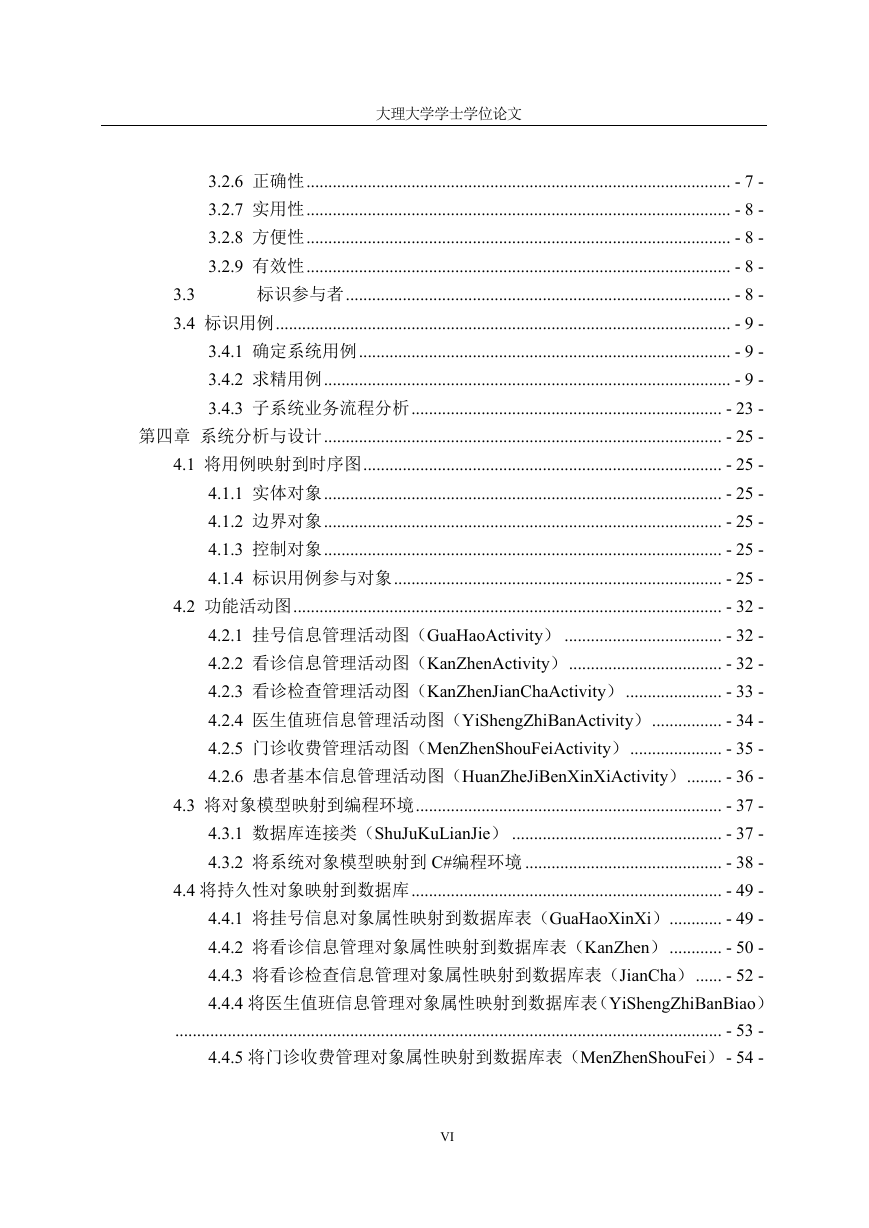大理大学本科毕业设计
基于三层架构的医院管理系统
——挂号管理、看诊管理、看诊检查管理、医生值班管理、门诊收费管理、
患者信息管理
THE HOSPITAL MANAGEMENT SYSTEM BASED ON
THREE-LAYER ARCHITECTURE
——THE REGISTRATION MANAGEMNET、THE VISITING MANAGEMNET、THE
INSPECTION MANAGEMNET、THE DOCTOR ON DUTY MANAGEMNET、THE
PATIENT INFORMATION MANAGEMNET
学 院: 数学与计算机学院
学生 姓名: 李冬梅
学 号: 2016115118
指导 教师: 某老师
专 业: 计算机科学与技术
年级(班级): 2016 级 1 班
起止 日期: 2019 年 6 月— 2019 年 12 月
�
�
摘 要
摘 要
众所周知,在科技日益发达的今天,计算机在各行各业不断受到人们的重视,同时
得到越来越广泛的应用,而且我们的生活也离不开互联网这样的信息时代,面对着互联
网的便利,我们越来越依赖它。因此,在这样的趋势下,人们的身体健康也备受重视,
医院也面临着信息时代的挑战。该医院管理系统主要是为患者创造一个良好的就医治疗
氛围,提供现代化的服务,提高医院服务效率,方便、快捷、准确的为患者提供医疗服
务和医疗费用信息,而且通过医院管理系统,可以使医院的管理工作自动化、系统化、
规范化,从而达到提高医院管理的效率,所以本系统是一款非常实用的现代化信息管理
软件。
本文主要论述的是该医院管理系统的开发思想、开发技术、开发平台以及分析、设
计、测试以及该系统包括了挂号信息管理、看诊信息管理、看诊检查管理、门诊收费管
理、医生值班信息管理、患者基本信息管理、职工基本信息的查询、后台管理(用户权
限设置以及登录验证)等的基本功能。充分运用了三层架构技术、数据库技术、计算机
技术、网络技术、报表打印技术等知识来构成该系统,为用户提供了强大的数据操纵功
能,并且本系统是基于 B/S 体系结构风格的,系统维护成本低。通过对所学的软件工程
知识,从需求分析入手,模型设计,编写用例、绘制用例图、绘制时序图、绘制类图、
绘制活动图、模型映射到 C#编程、映射到数据库、编写测试用例,以通过不断的测试
使系统更加的完善。
本系统采用的是以 ASP.NET 开发平台,C#为开发工具,三层架构为体系结构风格,
用 SQL Server 2017 存储数据,在 Windows10 操作系统下,用浏览器(Google Chrome、
IE、360 浏览器等)实现,以动态页面的形式交互,使用简单、操作方便,交互性强和
界面友好的医院管理系统。
关键词:挂号信息管理;看诊管理;医生值班管理;报表打印。
I
�
�
Abstract
Abstract
As we all know, with the development of science and technology, computers are being
paid more and more attention in all walks of life, and are being widely used. Moreover, our
life is inseparable from the information age such as the Internet. Facing the convenience of
the Internet, we rely on it more and more. Therefore, in such a trend, people's health is also
highly valued, and hospitals are also facing the challenge of the information age. Hospital
management system is mainly to create a good medical environment for patients, provide
modern services and improve the efficiency of hospital services, and it's accurate, convenient
and fast to provide medical services and medicine cost information for patients. In addition, it
can make the hospital management systematization, standardization and automation in order
to improve the efficiency of the hospital management through the hospital management
system. Hence, the system is significantly pratical modern information management software.
This article mainly discusses the development thought, technology and platform of
the hospital management system as well as the analysis, design, testing, and the system
includes some basic information like the registration information management, visiting
information and inspection management, the outpatient service charge management, patients
with the doctor on duty information management, management, employee basic information
query, background management (user permissions and login validation). It takes full
advantage of the knowledge of three-layer architecture technology, database technology,
computer technology, network technology and report printing technology to constitute the
system, providing users with a powerful data manipulation function. What'more, the system
with low maintenance cost is based on B/S architecture style. According to the knowledge of
software engineering, starting from the analysis of requirements, the design of the model, the
writting of the cases, the drawing of the case diagrams, drawing of timing diagrams, drawing
of class diagrams, the drawing of activity diagrams, and models are mapped to C#
programming, databases are mapped, and test cases are written, so as to make the system
more perfect through continuous testing.
This system adopts the ASP.NET development platform, regarding C# as the
development tool and taking the three-tier architecture as the architecture style. And it also
uses SQL Server 2017 to store data, and uses the browser (Google Chrome, IE, 360 browser,
etc.) to realize formal interaction of dynamic pages under the Windows10 operating system. It
is easy to use and convenient to operate, highly interactive and user-friendly to manage.
Key words: registration information management; visiting management; doctor on duty
management; report printing.
III
�
�
目 录
目 录
摘 要 ................................................................................................................................. I
Abstract ............................................................................................................................ III
目 录 ............................................................................................................................... V
第一章 绪 论 ............................................................................................................. - 1 -
1.1 系统开发的背景 ............................................................................................ - 1 -
1.2 系统开发的目标和意义 ................................................................................ - 1 -
1.2.1 系统开发的目标 ................................................................................. - 1 -
1.2.2 系统开发的意义 ................................................................................. - 1 -
1.3 国内外研究现状 ............................................................................................. - 2 -
1.3.1 国内研究现状 ...................................................................................... - 2 -
1.3.2 国外研究现状 ...................................................................................... - 2 -
1.4 论文组织结构 ................................................................................................ - 2 -
第二章 开发工具和运行环境 ..................................................................................... - 3 -
2.1 面向对象软件开发 ........................................................................................ - 3 -
2.1.1 面向对象编程 ...................................................................................... - 3 -
2.1.2 三层架构 ............................................................................................. - 3 -
2.2 Microsoft Visual Studio 2010 简介 ................................................................ - 3 -
2.3 SQL Server2017 简介 ..................................................................................... - 3 -
2.4 UML 简介 ....................................................................................................... - 4 -
2.5 B/S 模式简介 .................................................................................................. - 4 -
第三章 需求分析 ......................................................................................................... - 5 -
3.1 功能性需求 .................................................................................................... - 5 -
3.1.1 功能简介 ............................................................................................. - 5 -
3.1.2 功能详细说明 ..................................................................................... - 5 -
3.2 非功能性需求 ................................................................................................ - 7 -
3.2.1 可用性 ................................................................................................. - 7 -
3.2.2 可靠性 ................................................................................................. - 7 -
3.2.3 安全性 ................................................................................................. - 7 -
3.2.4 保密性 ................................................................................................. - 7 -
3.2.5 响应时间 ............................................................................................. - 7 -
V
�
大理大学学士学位论文
3.2.6 正确性 ................................................................................................. - 7 -
3.2.7 实用性 ................................................................................................. - 8 -
3.2.8 方便性 ................................................................................................. - 8 -
3.2.9 有效性 ................................................................................................. - 8 -
3.3
标识参与者 ........................................................................................ - 8 -
3.4 标识用例 ........................................................................................................ - 9 -
3.4.1 确定系统用例 ..................................................................................... - 9 -
3.4.2 求精用例 ............................................................................................. - 9 -
3.4.3 子系统业务流程分析 ....................................................................... - 23 -
第四章 系统分析与设计 ........................................................................................... - 25 -
4.1 将用例映射到时序图 .................................................................................. - 25 -
4.1.1 实体对象 ........................................................................................... - 25 -
4.1.2 边界对象 ........................................................................................... - 25 -
4.1.3 控制对象 ........................................................................................... - 25 -
4.1.4 标识用例参与对象 ........................................................................... - 25 -
4.2 功能活动图 .................................................................................................. - 32 -
4.2.1 挂号信息管理活动图(GuaHaoActivity) .................................... - 32 -
4.2.2 看诊信息管理活动图(KanZhenActivity) ................................... - 32 -
4.2.3 看诊检查管理活动图(KanZhenJianChaActivity) ...................... - 33 -
4.2.4 医生值班信息管理活动图(YiShengZhiBanActivity) ................ - 34 -
4.2.5 门诊收费管理活动图(MenZhenShouFeiActivity) ..................... - 35 -
4.2.6 患者基本信息管理活动图(HuanZheJiBenXinXiActivity) ........ - 36 -
4.3 将对象模型映射到编程环境 ...................................................................... - 37 -
4.3.1 数据库连接类(ShuJuKuLianJie) ................................................ - 37 -
4.3.2 将系统对象模型映射到 C#编程环境 ............................................. - 38 -
4.4 将持久性对象映射到数据库 ....................................................................... - 49 -
4.4.1 将挂号信息对象属性映射到数据库表(GuaHaoXinXi) ............ - 49 -
4.4.2 将看诊信息管理对象属性映射到数据库表(KanZhen) ............ - 50 -
4.4.3 将看诊检查信息管理对象属性映射到数据库表(JianCha) ...... - 52 -
4.4.4 将医生值班信息管理对象属性映射到数据库表(YiShengZhiBanBiao)
............................................................................................................................. - 53 -
4.4.5 将门诊收费管理对象属性映射到数据库表(MenZhenShouFei) - 54 -
VI
�
















 2023年江西萍乡中考道德与法治真题及答案.doc
2023年江西萍乡中考道德与法治真题及答案.doc 2012年重庆南川中考生物真题及答案.doc
2012年重庆南川中考生物真题及答案.doc 2013年江西师范大学地理学综合及文艺理论基础考研真题.doc
2013年江西师范大学地理学综合及文艺理论基础考研真题.doc 2020年四川甘孜小升初语文真题及答案I卷.doc
2020年四川甘孜小升初语文真题及答案I卷.doc 2020年注册岩土工程师专业基础考试真题及答案.doc
2020年注册岩土工程师专业基础考试真题及答案.doc 2023-2024学年福建省厦门市九年级上学期数学月考试题及答案.doc
2023-2024学年福建省厦门市九年级上学期数学月考试题及答案.doc 2021-2022学年辽宁省沈阳市大东区九年级上学期语文期末试题及答案.doc
2021-2022学年辽宁省沈阳市大东区九年级上学期语文期末试题及答案.doc 2022-2023学年北京东城区初三第一学期物理期末试卷及答案.doc
2022-2023学年北京东城区初三第一学期物理期末试卷及答案.doc 2018上半年江西教师资格初中地理学科知识与教学能力真题及答案.doc
2018上半年江西教师资格初中地理学科知识与教学能力真题及答案.doc 2012年河北国家公务员申论考试真题及答案-省级.doc
2012年河北国家公务员申论考试真题及答案-省级.doc 2020-2021学年江苏省扬州市江都区邵樊片九年级上学期数学第一次质量检测试题及答案.doc
2020-2021学年江苏省扬州市江都区邵樊片九年级上学期数学第一次质量检测试题及答案.doc 2022下半年黑龙江教师资格证中学综合素质真题及答案.doc
2022下半年黑龙江教师资格证中学综合素质真题及答案.doc